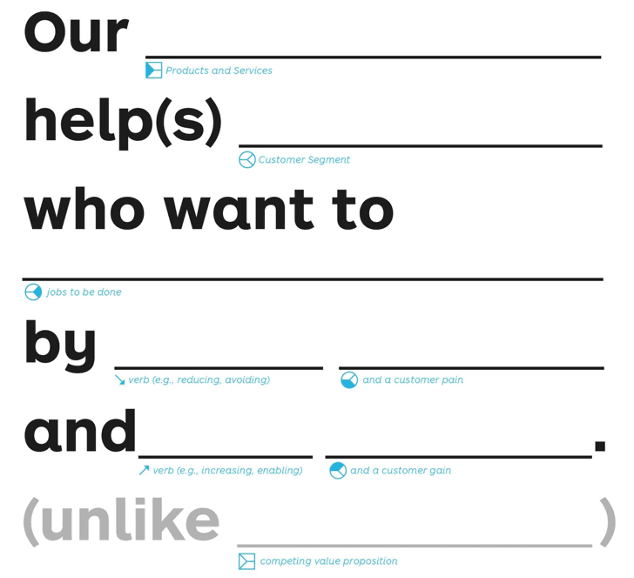Crafting a home run of a B2B value proposition is no easy task.
Maybe your company is gearing up to launch a new product. Needless to say, you’ve got a lot on your to-do list: interviewing customers, researching competitors, developing a GTM strategy, and the like. With all this on your plate, finding the time to properly draft, write, and revise the product’s value prop may seem like a stretch.
Or maybe you’ve been tasked with refreshing the value prop for one of your company’s offerings. You’re not exactly crunched for time, but you’re unsure of how to best attack the problem at hand.
Specifics aside, the importance of the work you’re doing should not be underestimated: When your company (or business unit) has a strong B2B value proposition, you can leverage it for better messaging, better content planning—even better sales scripts.
Whether you’re starting from scratch or revisiting an existing value prop, here’s the six-step process you can follow to maximize the quality of your final product:
- Define the problem
- Consider the impact on your customer
- Check out the value props your competitors use
- Try out tools to clarify your message
- Draft your B2B value proposition
- Share with your team
But before we get to the step-by-step guide, let’s make sure we’re on the same page with what a B2B value proposition is in the first place.
What is a B2B value proposition?
A B2B value proposition is a statement that conveys the unique benefits that a customer will experience using your company's product or service. This should follow your overall brand positioning, and it should align with your product or service messaging.
A value proposition should also be as compelling as possible. While it’s useful as a reference for the rest of your marketing and sales teams, the primary audience should be your customers.
That’s why “unique” is also key here. Your value proposition is your key to differentiating your company’s offering from its alternatives. Let’s look at this B2B value proposition example from Compt.

Here, Compt emphasizes that it’s simple and easy to use—something that not all companies offering employee perks can promise. That’s a great example of a simple, compelling value proposition that you can use as a model.
It’s also important to keep in mind that 69% of B2B companies have value propositions, according to HubSpot. That means you need to make sure your company's solution has a B2B value proposition in order to stack up against the competition. Even more importantly, though, you want a killer value proposition in order to beat your competitors and win more customers.
6 steps to a strong(er) B2B value proposition
Now, let’s walk through the six-step process of crafting a unique, compelling value prop—regardless of whether you’re starting from scratch.
1. Define the problem
You know that your product solves a problem. An easy-to-use employee perk platform like Compt saves time and sanity while improving employee morale. An all-in-one platform like Klaviyo makes growing an ecommerce business easier with all the tools you need for multi-channel marketing campaigns.
In order to convey the value of your offering, you need to define the problem it solves.
Now, the problem doesn’t necessarily have to be something broken or missing. Take Klaviyo’s “problem,” for instance. There are other tools that you can use to set up ecommerce email marketing, social media marketing, listening, and more—the problem is that, in most cases, those are going to be multiple tools. The solution isn’t solving something missing, it’s offering something better and more efficient.
Your problem could be similar. So take a look at your product, your marketing team, and your customers. This leads us to the next step.
2. Consider the impact on your customer
The solution that your company offers is one thing. The impact that solution has on your customer is another.
Let’s think about Hootsuite as an example. If I need a tool that lets me schedule social posts ahead of time in one place, then Hootsuite solves that problem. But the benefit goes well beyond just the ability to schedule tweets. It’s the ability to stop wasting time switching tabs and spend more time writing better social copy. It’s the ability to skip checking on weekends because I know that my posts will go through without a problem. That’s a way bigger, better benefit.
Using your brand personas to get started identifying these benefits for your value proposition is great. But talking to your customers is even better.
According to Product Marketing Alliance, 34.2% of product marketers talk to their customers as often as a few times each month.

If you can’t check in with customers directly, try your customer support or success team. Because they’re working directly with your customers, they’ll be able to offer insight into the real benefits your customers are already most excited about.
3. Check out the value propositions your competitors use
Your value proposition needs to be compelling to your customers—that’s why defining the problem and articulating the impact your solution has on them is so important. But your value proposition also needs to be unique.
Even similar products have different features, use cases, and more. It’s important to have the branding, positioning, and value propositions that differentiate them so that your customers and prospects know that, too.
So before you finalize any value proposition, you need to take the time to do some competitive analysis. Look into your competitors’ websites and marketing materials and find out how they’re explaining their value.
Make sure to go one step further, too, and do a competitive product analysis. This will give you a better idea of the features their product has and how it compares to your offering. Why’s this important for your value proposition? Because it’ll clarify where your product is superior—and even where your competitor is overpromising.
4. Try out tools to clarify your message
Once you have an idea of the problem, the impact, and the competitive landscape, it’s time to start clarifying your messaging. Luckily, there are tools you can use to help with this.
Harvard Business School recommends three essential questions to identify your value proposition:
- Which customers are you going to serve? (Or: Which customers do you serve?)
- Which needs are you going to meet? (Or: Which needs do you meet?)
- What relative price will provide acceptable value for customers and acceptable profitability for the company? (Or: Does the relative price of your solution provide acceptable value for customers and acceptable profitability for your company?)
These questions will prompt you to articulate exactly who you’re helping, how you’re helping them, and why your offering has the advantage—all helpful to have nailed down before drafting a value proposition and distributing it to your teams to share with customers.
When I’m writing, I find mapping out what I’m working on visually helps figure out the structure and the purpose. If you’re looking for something similar before you write (or rewrite) your value proposition, you can try out Strategyzer’s Value Proposition Canvas. This is a graphic template that you can fill out to provide a holistic picture of your product, its appeal, and its impact.
This visualization is a great way to identify your moving parts and start drafting your value proposition, which leads us to the next step.
5. Draft your B2B value proposition
Notice the verb in this step? It isn’t write your value proposition or confirm your value proposition; it’s draft. This should be a process, one where you write and workshop and rewrite until you have a killer value proposition that’s appealing to your customers.
How should you do that? Start with a template.

Via Daniel Nilsson.
This template is simple and to the point, and it’ll help you put all of the ideas from the previous steps into a clear, concise sentence. But remember, this is a starting point.
The next step? Try to get more specific and more descriptive. Then share with your team, workshop, and try again.
When you’re drafting, make sure you’re keeping your brand identity in mind. Your value proposition should be recognizably on brand. Is your brand voice casual and friendly? Make sure your statement is, too. Is your messaging playful and engaging? Make sure your value proposition is, too.
That way, your value proposition is ready for everyone in your company to use to talk to prospects and customers, which leads us to the final step.
6. Share with your team
I always get so frustrated if I’m the last member of the team to have access to campaign or product messaging—or, worse, to find out that there was an updated message map everyone else has been using for months. FOMO? Not really. It’s frustrating when you’re doing work without the same information because alignment is so important. And, in this case, it’s straightforward.
You just need to share your B2B value proposition with your team as soon as it’s ready.
Whether that’s a shared doc, a pin in Slack, or an email update, you need to send out the messaging to your team so that they can use it to inform their marketing copy, their sales conversations, even their customer calls.
So distribute your value proposition, and then keep it in conversation so that your whole team knows the messaging—that’s the best way to make sure you’ve got a killer value proposition.
Use your B2B value proposition to win over prospects
It takes a lot to identify a strong value proposition that stands out against the noise, but it’ll improve your product marketing—and, ideally, your bottom line—to spend the time to get it right. A strong value proposition will help make sure your teams are aligned on the benefits of your product and your customers are all excited about the solution you’re offering.

Related Blog Posts
Popular Posts
-
 How to Create a Competitive Matrix (Step-by-Step Guide With Examples + Free Templates)
How to Create a Competitive Matrix (Step-by-Step Guide With Examples + Free Templates)
-
 The 8 Free Market Research Tools and Resources You Need to Know
The 8 Free Market Research Tools and Resources You Need to Know
-
 Sales Battlecards 101: How to Help Your Sellers Leave the Competition In the Dust
Sales Battlecards 101: How to Help Your Sellers Leave the Competition In the Dust
-
 6 Competitive Advantage Examples From the Real World
6 Competitive Advantage Examples From the Real World
-
 How to Measure Product Launch Success: 12 KPIs You Should Be Tracking
How to Measure Product Launch Success: 12 KPIs You Should Be Tracking





